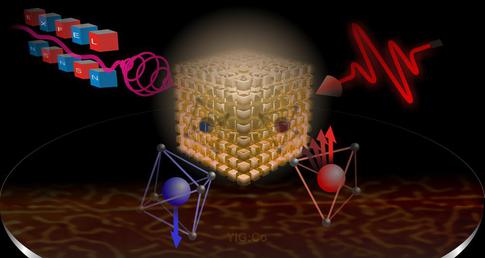XFEL: Mechanism of light-driven magnetization switching revealed
Mechanism of light-driven magnetization switching revealed

Principle of the experiment: An ultrashort near-infrared laser pulse (top right) triggers changes in the iron sublattices of YIG:Co (below centre), which are then analysed using the X-ray pulses of the European XFEL (top left). Credit: Prof. Andrzej Stupakiewicz, Department of Magnetism, Faculty of Physics, University of Bialystok, Poland
Switching the magnetization of materials—for example in hard drives used for data storage—with light instead of magnetic fields promises to significantly accelerate data writing speed. The recent demonstration of magnetization switching with only one light pulse in a controllable way was a significant advance in the field. A team of scientists has now explored the microscopic mechanism behind magnetization switching triggered by an ultrashort near-infrared laser pulse and elucidated the switching dynamics on the atomic level using the X-ray pulses of the European XFEL. The results confirm a novel and effective optical switching mechanism, which could be used to provide ultrafast magnetization control in a wide variety of materials. The work was published in Advanced Science.
As the amount of data generated across the world grows, demand also increases for faster, more energy-efficient, and denser data storage solutions. Today’s hard drives are based on magnetic materials whose magnetization is typically switched by a local magnetic field to write bits of data to the drive. This data writing speed is limited, however. Using ultrashort pulses of light instead of a magnetic field to switch the magnetization could reduce data writing times significantly.
A team of scientists has now used an ultrashort infrared laser pulse to reveal the underlying microscopic mechanism of magnetization switching in cobalt-doped yttrium iron garnet (YIG:Co) by means of ultrafast X-ray spectroscopy at the SCS instrument of the European XFEL. “The near-infrared light pulse triggers an electronic transition in the cobalt ions in the sample, which in turn induces a reorientation of the spins of the nearest iron ions,” explains Sergii Parchenko from ETH Zurich, Paul Scherrer Institute, and European XFEL, the first author of the publication. “The reorientation cascade propagates during one picosecond away from the initial cobalt ion until a homogenous state is achieved. This creates a situation in which the magnetic moments are canted. This transient state seems to be crucial for magnetization switching.”

Schematic visualization of the microscopic magnetization dynamics in YIG:Co, showing only cobalt (Co, blue) and iron (Fe, green) ions in the tetrahedral sublattice. (a) Prior to illumination with the infrared pulse, all magnetic moments are aligned. (b) The optical excitation changes the orbital state of the cobalt ion, inducing the reorientation of the spins of the nearest iron ions. (c, d) The reorientation cascade (dashed orange circle) propagates away from the initially excited cobalt ion, affecting iron ions located further away. From https://doi.org/10.1002/advs.202302550
In YIG:Co, the iron ions are arranged in two distinct sublattices. The magnetic moments in each sublattice are normally aligned with those in the other sublattice, but pointing in opposite directions. As the study showed, the two sublattices react differently to the optical excitation of the cobalt ions, resulting in a transient state in which the magnetic moments are not aligned anymore. “Even a tiny change in the pointing of the magnetization of one sublattice significantly affects the total magnetization of the material, effectively resulting in a switch of the magnetization,” says Parchenko.
The novel all-optical switching mechanism revealed in the study could be used to control the spins of many other materials on the atomic level on ultrafast time scales, with possible applications for faster and more energy-efficient data storage solutions.
Reference:
“Transient non-collinear magnetic state for all-optical magnetization switching”, Sergii Parchenko et al., Adv. Sci. 2302550 (2023), https://doi.org/10.1002/advs.202302550
Scientific contact:
Dr Sergii Parchenko
Tel: +49-40-8998-6071
E-mail: sergii.parchenko@xfel.eu
Prof. Andrzej Stupakiewicz
Tel: +48-85-738-81-78
E-mail: and@uwb.edu.pl
Dr Urs Staub
Tel: +41-56-310-44-94
E-mail: urs.staub@psi.ch
Media contact:
Dr Bernd Ebeling
Tel: +49-40-8998-6921
E-mail: bernd.ebeling@xfel.eu
